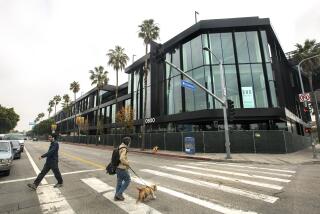SDSU Foundation Plans to Develop 64 Prime Acres
- Share via
The San Diego State University Foundation announced Thursday that it will develop 64.5 acres of prime university property as part of a long-range master plan--a proposal that stirred controversy when it was first unveiled in April.
Foundation General Manager Harry Albers said the group plans to hire a private developer from the San Diego area to orchestrate the elaborate redesign over a 15- to 20-year period.
“The growth of the university has brought about a lot of changes to the surrounding community,” Albers said. “With the current 35,000 students, you have problems with traffic, parking, noise. . . . The university, city and community have worked together ceaselessly to try to solve these things. We see this as the best solution. We want to make this area the most it possibly can be.”
The mixed-use redevelopment aims to consolidate parking and housing for students, adding new areas and merging old ones, Albers said. Officials said they hope to create a main gate, or new entrance, for SDSU that would resemble those at UC Berkeley, Harvard University and the University of Virginia. The project would include a smattering of shops, walkways and greenbelts, Albers said.
Three main areas are targeted for development under the university’s plan:
- The primary site, which borders SDSU’s existing entrance to the north, Montezuma Road to the south, College Avenue to the east and 55th Street to the west. This site covers 37 acres.
- The 55th Street site, starting at the northern end of 55th Street and bordering the intersection of 55th Street and Remington Road. This area covers 10 acres.
- The Alvarado site, next to Interstate 8 and south of Alvarado Road, covering 17.5 acres.
Most of the early controversy involved the primary site, which contains some of the oldest and most historic buildings on campus. Many are SDSU religion centers, housing the school’s Catholic, Jewish and Protestant organizations. Most of these groups own the property on which their centers are built.
Early Critic of Plan
An early critic of the plan was the Rev. William Mahedy, an Episcopal priest who maintains an office in the Lutheran Campus Center on Hardy Avenue. Mahedy said his concern was that property owners--the ministries themselves--were being “hoodwinked” by developers.
“My problem with all of this is that I smell big money,” Mahedy said at the time. “The foundation is being very cavalier in presenting the plan, and that I resent. I think the plan represents a slick hustle with big money behind it. The idea for us is to quietly acquiesce. But, of course, if the foundation wants it, and the university wants it, sooner or later they’ll get it.”
Albers said campus religious opposition had quieted down. He called the redevelopment plan a product of months of discussion in town hall meetings and private conferences.
“We’ve worked with them (the ministries), and they’ve agreed on new locations within that boundary (of the primary site),” Albers said. “We don’t know yet if they’ll all be in one building, or if they’ll remain in existing locations. But they will be somewhere in that area. The problem with their existing locations is that some of those buildings are substandard, and some of these groups have expressed interest in new facilities.”
Sept. 13 Deadline
Albers said the foundation has set a deadline of 2 p.m. Sept. 13 for developers to file proposals. Selection of what he called “the joint-venture partner” will occur in mid-October. He said a conference to address questions from the public will take place from 8:30 to 11 a.m. Thursday in the Aztec Center.
Cost for the project will be “borne by the private sector,” he said, “and we don’t yet have a notion of what the bottom line will be.” He said the developer would bear “infrastructure fees for walkways, green areas and shops.”
“We hope for a mixture of new shops, residential units for students and faculty, and university-related office buildings,” Albers said. “The project could last as long as two decades, but we won’t get started, in my view, for two more years at least. We’re really excited about it. We think it marks a major change--and, we hope, a major improvement.”
More to Read
Sign up for Essential California
The most important California stories and recommendations in your inbox every morning.
You may occasionally receive promotional content from the Los Angeles Times.













